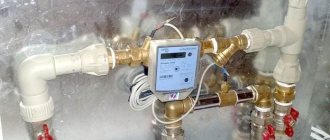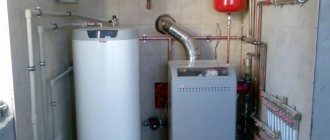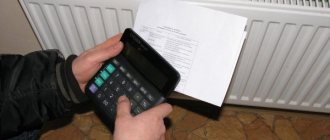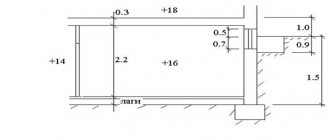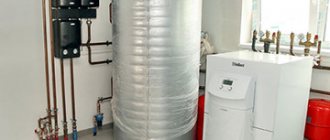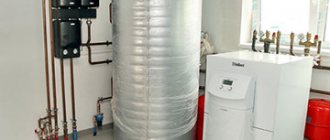Comments
The procedure for calculating the amount of heating fees, which will be discussed in this article, has been in effect since January 1, 2019 and is relevant in 2022 and 2022.
A feature of the current calculation formulas is that the methods for calculating the amount of heating fees take into account the readings of individual heat energy meters , regardless of how many rooms in an apartment building are equipped with them (previous calculation methods excluded this possibility).
In addition, for premises that do not have heating devices (radiators, radiators), or that have their own (individual) sources of thermal energy , it is also possible to make payments, taking into account the fact that they do not actually consume the thermal energy supplied to the apartment building specifically in their premises.
Calculation of heating fees in apartment buildings
General principles for performing Gcal calculations
Calculating kW for heating involves performing special calculations, the procedure of which is regulated by special regulations. Responsibility for them lies with utility organizations that are able to help with this work and give an answer regarding how to calculate Gcal for heating and the decoding of Gcal. Of course, such a problem will be completely eliminated if there is a hot water meter in the living room, since it is in this device that there are already pre-set readings that display the heat received. By multiplying these results by the established tariff, it is possible to obtain the final parameter of the heat consumed.
Heat meters
Now let’s find out what information is needed in order to calculate the heating. It's easy to guess what this information is.
1. Temperature of the working fluid at the outlet/inlet of a specific section of the pipeline.
2. The flow rate of the working fluid that passes through the heating devices.
Consumption is determined through the use of heat metering devices, that is, meters. These can be of two types, let’s get acquainted with them.
Vane meters
Such devices are intended not only for heating systems, but also for hot water supply. Their only difference from those meters that are used for cold water is the material from which the impeller is made - in this case it is more resistant to elevated temperatures.
As for the mechanism of operation, it is almost the same:
- due to the circulation of the working fluid, the impeller begins to rotate;
- the rotation of the impeller is transmitted to the accounting mechanism;
- transmission is carried out without direct interaction, but with the help of a permanent magnet.
Despite the fact that the design of such meters is extremely simple, their response threshold is quite low, moreover, there is reliable protection against distortion of readings: the slightest attempts to slow down the impeller through an external magnetic field are stopped thanks to an antimagnetic screen.
Devices with a difference recorder
Such devices operate on the basis of Bernoulli's law, which states that the speed of a gas or liquid flow is inversely proportional to its static movement. But how does this hydrodynamic property apply to calculations of working fluid flow? It’s very simple - you just need to block its path with a retaining washer. In this case, the rate of pressure drop on this washer will be inversely proportional to the speed of the moving flow. And if the pressure is recorded by two sensors at once, then the flow can be easily determined, and in real time.
Note! The design of the meter implies the presence of electronics. The vast majority of such modern models provide not only dry information (temperature of the working fluid, its consumption), but also determines the actual use of thermal energy. The control module here is equipped with a port for connecting to a PC and can be configured manually.
Many readers will probably have a logical question: what to do if we are not talking about a closed heating system, but about an open one, in which selection for hot water supply is possible? How to calculate Gcal for heating in this case? The answer is quite obvious: here pressure sensors (as well as retaining washers) are installed simultaneously on both the supply and the “return”. And the difference in the flow rate of the working fluid will indicate the amount of heated water that was used for domestic needs.
Calculation procedure when calculating heat consumption
In the absence of such a device as a hot water meter, the formula for calculating heat for heating should be as follows: Q = V * (T1 - T2) / 1000. The variables in this case display values such as:
- Q in this case is the total amount of heat energy;
- V is the indicator of hot water consumption, which is measured either in tons or in cubic meters;
- T1 – temperature parameter of hot water (measured in standard degrees Celsius). In this case, it would be more appropriate to take into account the temperature that is characteristic of a certain operating pressure. This indicator has a special name - enthalpy. But in the absence of the required sensor, you can take as a basis the temperature that will be as close as possible to the enthalpy. As a rule, its average varies between 60 and 65°C;
- T2 in this formula is the temperature indicator of cold water, which is also measured in degrees Celsius. Due to the fact that getting to the pipeline with cold water is very problematic, such values are determined by constant values, which differ depending on the weather conditions outside the home. For example, in the winter season, that is, at the height of the heating season, this value is 5°C, and in the summer, when the heating circuit is turned off, it is 15°C;
- 1000 is a common coefficient that can be used to get the result in gigacalories, which is more accurate, rather than in regular calories.
What is all this for?
The problem should be considered from two points of view - from the point of view of apartment buildings and private ones. Let's start with the first ones.
Apartment buildings
There is nothing complicated here: gigacalories are used in thermal calculations. And if you know how much thermal energy remains in the house, then you can present the consumer with a specific bill. Let's give a small comparison: if centralized heating operates in the absence of a meter, then you have to pay according to the area of the heated room. If there is a heat meter, this in itself implies a horizontal wiring type (either collector or serial): two risers are brought into the apartment (for “return” and supply), and the intra-apartment system (more precisely, its configuration) is determined by the residents. This kind of scheme is used in new buildings, thanks to which people regulate the consumption of thermal energy, making a choice between savings and comfort.
Let's find out how this adjustment is carried out.
1. Installation of a general thermostat on the return line. In this case, the flow rate of the working fluid is determined by the temperature inside the apartment: if it decreases, the flow rate will accordingly increase, and if it increases, it will decrease.
2. Throttling of heating radiators. Thanks to the throttle, the passage of the heating device is limited, the temperature decreases, and therefore the consumption of thermal energy is reduced.
Private houses
We continue to talk about calculating Gcal for heating. Owners of country houses are interested, first of all, in the cost of a gigacalorie of thermal energy obtained from one or another type of fuel. The table below may help with this.
Table. Comparison of cost of 1 Gcal (including transport costs)
| Name of energy resource | Approximate cost, in rubles* |
| Gas (liquefied) | 520 |
| Gas (natural) | 3 300 |
| Coal | 550 |
| Diesel fuel | 3 270 |
| Pellets | 1 800 |
| Electric Energy | 4 300 |
* - prices are approximate, since tariffs may differ depending on the region, moreover, they are constantly growing.
Other methods for calculating heat volume
You can calculate the amount of heat entering the heating system in other ways. The formula for calculating heating in this case may differ slightly from the above and have two options:
- Q = ((V1 * (T1 - T2)) + (V1 - V2) * (T2 - T)) / 1000.
- Q = ((V2 * (T1 - T2)) + (V1 - V2) * (T1 - T)) / 1000.
All variable values in these formulas are the same as before. Based on this, we can say with confidence that the calculation of kilowatts of heating can be done on your own. However, do not forget about consultation with special organizations responsible for supplying heat to homes, since their principles and calculation system may be completely different and consist of a completely different set of measures.
Having decided to construct a so-called “warm floor” system in a private house, you need to be prepared for the fact that the procedure for calculating the volume of heat will be much more complicated, since in this case it is necessary to take into account not only the features of the heating circuit, but also provide for the parameters of the electrical network from which and the floor will be heated. At the same time, the organizations responsible for monitoring such installation work will be completely different. Many owners often face the problem of converting the required amount of kilocalories into kilowatts, which is due to the use of measuring units in the international system called “C” by many auxiliary aids. Here you need to remember that the coefficient converting kilocalories into kilowatts will be 850, that is, in simpler terms, 1 kW is 850 kcal. This calculation procedure is much simpler, since calculating the required volume of gigacalories is not difficult - the prefix “giga” means “million”, therefore, 1 gigacalorie is 1 million calories.
In order to avoid errors in calculations, it is important to remember that absolutely all modern heat meters have some error, but often within acceptable limits. The calculation of such an error can also be done independently, using the following formula: R = (V1 - V2) / (V1+V2) * 100, where R is the error of the common house heating meter, V1 and V2 are the water flow parameters already mentioned above in the system , and 100 is the coefficient responsible for converting the resulting value into a percentage.
In accordance with operational standards, the maximum permissible error may be 2%, but usually this figure in modern instruments does not exceed 1%.
Taking readings
If there is a household flow meter in each room of an apartment building, correct recording of information allows you to avoid erroneous charges or recalculations. Standard data acquisition scheme, which is applicable to most heat meters:
- There is a button on the device that switches the information accumulated by the device. To quickly move the pop-up values, you need to press with a slight delay.
- The first to be displayed is the date and time, displayed in the set format.
- This is usually followed by different temperature parameters corresponding to the inlet and outlet pipes. Functional flow meters are capable of analyzing the temperature difference and current power.
- The next indicator is energy, measured in Gcal. This data needs to be removed from the screen. There are counters that do not keep track of gigacalories, although they are extremely rare. When displaying values in kW/h, values in Gcal must be calculated taking into account that 1000 kW/h = 1 MW/h = 0.86 Gcal. If information is taken from the device in GJ, the conversion to gigacalories occurs as follows: 1 GJ = 0.24 Gcal. Below in the menu you can see the volume and flow rate of the coolant.
The control panels on all powerful certified devices operate on the same principle and, when pressing keys, they alternately provide the necessary data
Based on the available values, an independent calculation of thermal energy is carried out, taking into account the calculation of Gcal for the calculation period. This will allow you to get an amount that you can use as a guide if the readings on the receipt differ significantly. According to RF PP No. 354, the following formula applies:
Pi = (Vin + Viodn × Si / Sob) × TT
Viodn = VD - ΣVin
To calculate the amount that needs to be paid, you will need to find out the data of the common building meter, all individual devices, the area of common premises and a personal apartment. The final calculation is as follows (based on approximate data): Pi = (Vin[IPU 2Gcal] + Viodn[ODN 15Gcal] × Si [apartments-40m2] / Sob[houses-5000m2]) × TT[Tariff for Moscow - 1747, 47 rub.]
Pi=(2+15×40÷5000)×1747.47
Total: Pi=3704.64 rub.
The specified amount will have to be paid for the billing period. ADI is defined separately as the difference between the TDI and all readings of individual IPUs.
Timely transmission of information taken from the thermal energy meter eliminates problems. The resource supplying organization sets a certain period during which information must be sent using a suitable method. The term is specified in the concluded contract.
You can submit heating meter readings in the following ways:
- When contacting the office of the utility service provider in person.
- When paying a receipt at a payment center.
- By phone.
Available options for each apartment building must be presented in the office of the heat supply organization or management company, at a stand with legal information.
How is heating calculated using a common house meter?
A special procedure applies if not all premises of a multi-storey building are equipped with individual metering devices. The rules apply even to properties in which only one apartment is located without a heat meter. Houses with expired IPU verification also fall under existing standards. The exact definition of all legal factors must be read in RF PP No. 354.
The most profitable option is to install a centralized meter with simultaneous duplication of readings with individual metering devices
- In such situations, the monthly fee is calculated using the formula:
- Pi = VД × Si / Sob × CT
- The designations are as follows:
- VD is the total volume of thermal energy, which is calculated based on data received from the ODPU.
- Si - area of an apartment or other premises, part of an apartment building.
- Sob - the area of the entire apartment building, including residential and non-residential premises.
- TT is a tariff for a specific subject of the Russian Federation, on the basis of which payment for heat is calculated. From the second half of 2022, there was an increase in current prices.
An example of a calculation for a common house meter would be the following option:
- VD - 300 Gcal.
- Si - 40 m2.
- Sob - 6000 m2.
- TT - for the population of the city of Moscow (subject to a number of conditions) - 1747.47 rubles.
- It is required to calculate based on the existing formula as follows:
- Pi=300×40/6000×1747.47
- Pi=3494.94 rub.
- This amount is paid for an apartment with an area of 40 m2 with the specific parameters of a multi-storey building.
Summary of all calculations
Correctly performed calculation of thermal energy consumption is the key to economical expenditure of funds spent on heating. Giving an example of the average value, it can be noted that when heating a residential building with an area of 200 m² in accordance with the calculation formulas described above, the volume of heat will be approximately 3 Gcal per month. Thus, taking into account the fact that the standard heating season lasts six months, then over six months the consumption volume will be 18 Gcal.
Of course, all measures for calculating heat are much more convenient and easier to carry out in private buildings than in apartment buildings with a centralized heating system, where simple equipment cannot be used.
